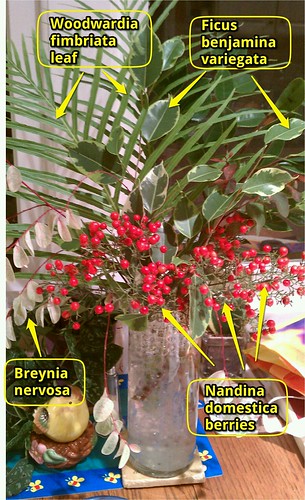How much should I water my plant?
Gardening tips from a professional horticulturist. Let's keep exploring this wonderful world of plants together.
Friday, December 28, 2012
Holiday plant arrangement--Use what's in your garden!
Holiday plant arrangement cut fresh from the garden in Southern CA
If you're fortunate enough to live in a climate which doesn't freeze during the Winter and in which you can grow semi-tropical plants, then you're able to cut some living floral arrangements for special occasions and holidays. Even if you don't live in such a climate, it's still possible create a nice piece which reflects your regional plant palette.
Since the traditional Winter holidays are usually associated with greens, reds and whites, I decided to use those basic colors and variations on them in the arrangement. With color as the basis for the plant collection, off I went, into the garden with my trusty pruners to do some selective trimming.
Since I didn't have access to the traditional holly berries, instead I used the red berries of Nandina domestica or Heavenly Bamboo, labelled below. In order to get the white in, the variegation of the Ficus benjamina or commonly known as Weeping Banyan. The lacy effect of the green-leafed Woodwardia fern gives the composition some upward height and keeps it feeling airy and not too 'heavy".
For a little interest and plant geekiness, in went the Breynia nivosa [please excuse the incorrect spelling annotation in the pic] or Snow bush. A couple of cool attributes of this plant are the white/green/pinkish-red leaves and the red stems, thus its inclusion in the mix.
There's one other plant hiding in the arrangement and there's extra kudos-credit to anyone who finds it and comments on it and its name. What are some of your favorite arrangements holiday arrangements?
Monday, December 17, 2012
"Dirt, soil, whatever. Does it really matter?"
"Dirt, soil, whatever. Does it really matter?"
Welcome to the quirky, jargon-y world of gardening. We don't have to get all Genus and species here right now but this is one of those geeky words, when used with other gardeners/horticulturists/designers/et al. will get you instant credibility and, dare I say, more respect and cooperation. I'm not saying that it's right, just what is. In the world of gardening, "When in Rome..."
Say, for instance, you want to put the plant Aunt Sadie gave you into a larger pot, since the plant has grown quite a bit since she gave it to you. . You go to your local gardening establishment and ask for "dirt." The person you're speaking with, if they're worth their weight in vermiculite, will most likely say, "Would you like a bag of topsoil?" Why? Because most people who say "dirt," mean that regular, ol' backyard soil, the stuff the grass grows on, also known as topsoil.
But in this case, you wouldn't want topsoil, you'd want something else. Now you're confused. Dirt is dirt, right? Hopefully, the pro you're speaking with will, in their next question, ask what you're going to be using this for and determine what are the best options to offer you, which in this case would most likely be potting soil.
"Why do I bring this point up?" you might ask. Because giving a plant the most "correct" soil is one of the most important things you can do for its success and health. I say "correct" because it's a matter of ratios between sand, loam and silt and in what proportion each type of plant prefers to have its roots in, basically.
One of my wise teachers once said to us, "Think like a plant." In our case of choosing soils, "What kind of soil does the plant naturally grow in?" Try to recreate its natural growing environment as best that you can. Does it grow naturally on a sandy island, with well-drained soil? Does it naturally grow in a heavy, clay soil? Or does it grow in an acidic, understory environment? Knowing from where a plant derives in nature, can tell you a lot about in what conditions it will thrive.
Look for more posts in the future about soils. Add any questions you might have in the comments section and, as always, let's keep asking questions together.
Tuesday, December 4, 2012
You might have asked, "How much water should I give my plant?"
This is by far, the most-often-asked question I get as a professional horticulturist. It's also one of the hardest to answer, because of the many variables involved. But I really disliked not being able to give very earnest, wanting-to-be-successful gardeners a good answer so I set about to find an easy-to-convey answer and here it is.
First off, if the plants are getting water everyday it is too much. Waaaay too much. You're probably not doing this yourself, but if you know someone who is, tell them to Stop!!(wink wink) Plants given daily water will most likely die from too much kindness, TLC, from perfectly good intentions. Fear not, there is help!
This is a generalized rule for normal plants, under normal circumstances (See? There are those pesky variables again.) "Normal" in this case means not rootbound (large plants which are in too-small pots and whose roots fill the pot volume {more on roots and pot volume in another post}) and not in full, hot sun.
So, here's the hot tip: if you keep the plant's soil moist, like a well-wrung out (dish) sponge, there shouldn't be any problems with underwatering or overwatering.
Here's the other secret to watering plants that if you follow, for most plants, will always serve you well. If a plant looks to be wilting and its size makes it easy to lift, pick it up and feel the weight of the soil heaviness within the pot: if it's heavy &/or has been sitting in a pool of water, it's too wet and you should let it dry out. If however, the pot and soil feel light and it's wilting, it's most likely too dry and needs water.
If you try these methods, they should lead to greater success in gardening. Let me know how it works out.
First off, if the plants are getting water everyday it is too much. Waaaay too much. You're probably not doing this yourself, but if you know someone who is, tell them to Stop!!(wink wink) Plants given daily water will most likely die from too much kindness, TLC, from perfectly good intentions. Fear not, there is help!
This is a generalized rule for normal plants, under normal circumstances (See? There are those pesky variables again.) "Normal" in this case means not rootbound (large plants which are in too-small pots and whose roots fill the pot volume {more on roots and pot volume in another post}) and not in full, hot sun.
So, here's the hot tip: if you keep the plant's soil moist, like a well-wrung out (dish) sponge, there shouldn't be any problems with underwatering or overwatering.
Here's the other secret to watering plants that if you follow, for most plants, will always serve you well. If a plant looks to be wilting and its size makes it easy to lift, pick it up and feel the weight of the soil heaviness within the pot: if it's heavy &/or has been sitting in a pool of water, it's too wet and you should let it dry out. If however, the pot and soil feel light and it's wilting, it's most likely too dry and needs water.
If you try these methods, they should lead to greater success in gardening. Let me know how it works out.
Subscribe to:
Posts (Atom)



